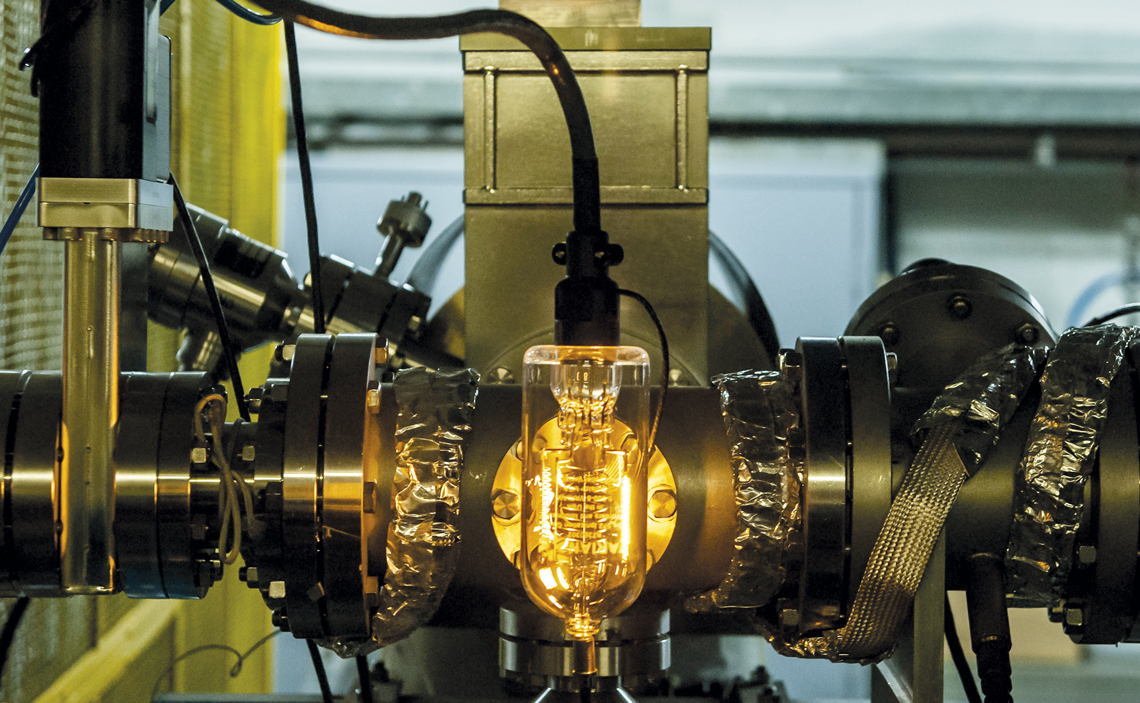Installed in a nine-story building specifically built to house it at the University of São Paulo’s Institute of Physics (IF-USP), the particle accelerator at the Open Nuclear Physics Laboratory (LAFN) was inaugurated amid great fanfare in January of 1972. Scientists wore suits and ties to present the new facilities to the authorities. The Military Police’s brass band welcomed guests to the building’s entrance with “Pra frente, Brasil” (Onward, Brazil), which was the theme song for the Brazilian national team at the 1970 World Cup and which was later utilized by military regime propaganda.
Named the Pelletron, the accelerator was seen as a passport to the future, an instrument that would bring Brazilian science closer to the frontier of knowledge in a field that seemed essential to the country’s technological development. It has trained generations of researchers and is still standing in its concrete tower, even after larger and more modern machines have been produced.

GURGEL, I. and MUNHOZ, M. G. et al. (orgs.). 50 years with the Pelletron particle accelerator: Voices from history. 2022
Under construction, the eight-story concrete towerGURGEL, I. and MUNHOZ, M. G. et al. (orgs.). 50 years with the Pelletron particle accelerator: Voices from history. 2022After more than half a century, USP physicists are seeking partnerships to modernize it and keep it in operation. This type of equipment is usually decommissioned when it becomes obsolete or when the high operating costs outweigh the benefits obtained by scientists. The Tevatron accelerator, which enabled the discovery of the atomic particle known as the top quark, was inaugurated in the United States in 1983 and decommissioned in 2011, just over 18 years after the top quark was identified. It was much larger than the Pelletron, but the Americans decided that it was no longer worth the cost of maintaining it and decided to invest in more powerful equipment.
The Pelletron is an electrostatic accelerator, in which large amounts of energy produce a powerful electric field capable of propelling ionized (electrically charged) atoms at around 20% of the speed of light. The device causes atomic nuclei to collide, revealing new details about the structure of particles and their interactions.
The accelerator has made various types of research possible. In basic physics, scientists investigate the unstable behavior of so-called exotic nuclei, which have more protons or neutrons than the stable nuclei of the same chemical elements. Installed in 2004, RIBRAS (Radioactive Ion Beams in Brazil), is one of the systems connected to Pelletron and dedicated to these types of studies.
A newer system, which was commissioned in 2016, allows scientists to analyze how radiation affects electronic devices. In recent years, it was used to improve circuits developed for Brazilian satellites, under the Ministry of Science, Technology, and Innovation’s “Radiation Tolerant Integrated Circuits” (CITAR) project.
There are more than four of this same type of accelerator in operation at USP and other Brazilian universities, but they are much smaller and generally used for analyzing materials. With the ability to reach an electrical voltage equivalent to eight million volts, LAFN’s Pelletron is the only one of its kind in the country and one of the largest operating accelerators in the Southern Hemisphere. Argentina has a device capable of generating 20 million volts, but the high operating costs prevent it from reaching that level.
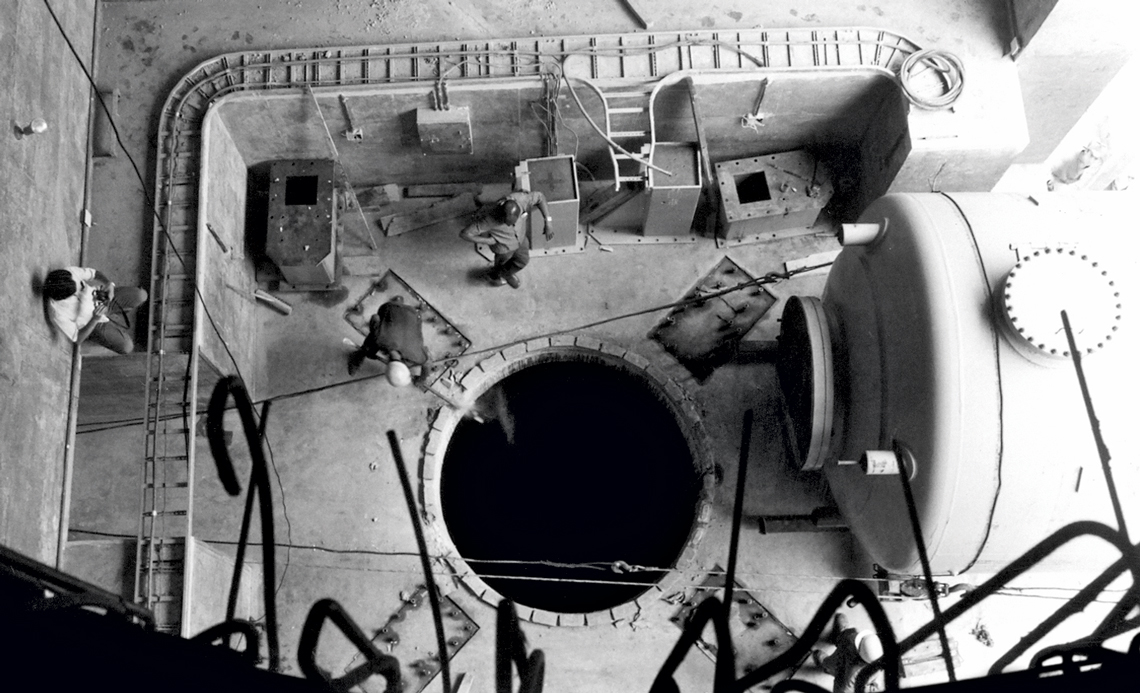
GURGEL, I. and MUNHOZ, M. G. et al. (orgs.). 50 years with the Pelletron particle accelerator: Voices from history. 2022
The three-story accelerator tank roomGURGEL, I. and MUNHOZ, M. G. et al. (orgs.). 50 years with the Pelletron particle accelerator: Voices from history. 2022“The Pelletron is still strategic for the country,” states physicist Leandro Gasques, who took over as the laboratory director this year. “We train personnel, we use cutting-edge technology in the systems associated with the accelerator, and we are highly competitive, as demonstrated by the findings we have published in prestigious international journals.” USP’s accelerator has helped train 108 masters and 75 doctors since 1975. In recent years, its researchers have published an average of eight scientific articles per year with findings obtained using the Pelletron.
“It is still incredibly useful for researching interesting questions in basic physics, despite the fact that many researchers are migrating to large accelerators and more applied research,” says USP physicist Marcelo Munhoz, one of the people behind the book 50 anos do acelerador de partículas Pelletron: Vozes de uma história (50 years with the Pelletron particle accelerator: Voices from history; USP’s Institute of Physics, 2022).
The price of pioneering
Physicist Oscar Sala (1922–2010), who was an IF-USP professor, scientific director (1969–1975), and chairman (1985–1995) of the FAPESP Board of Directors, initiated acquiring the device. He had been sent to the United States to study the subject after World War II (1939–1945) and, upon his return, he designed the first electrostatic accelerator built in Brazil, installed at USP in the 1950s, with help from the national industry and funds from the Rockefeller Foundation. In the 1960s, Sala concluded that it had become obsolete and needed to be replaced.
The opportunity arose in 1965, when a group led by American physicist Raymond Herb (1908–1996), who helped Sala design the first device, founded a company to develop a new type of accelerator, the National Electrostatics Corporation (NEC), in the United States. Its main innovation was the means used to transport electrical charge inside the device, a chain made of metal pellets, small cylinders connected to pieces of plastic material. This gave rise to the device’s name, Pelletron, a trademark registered by NEC.
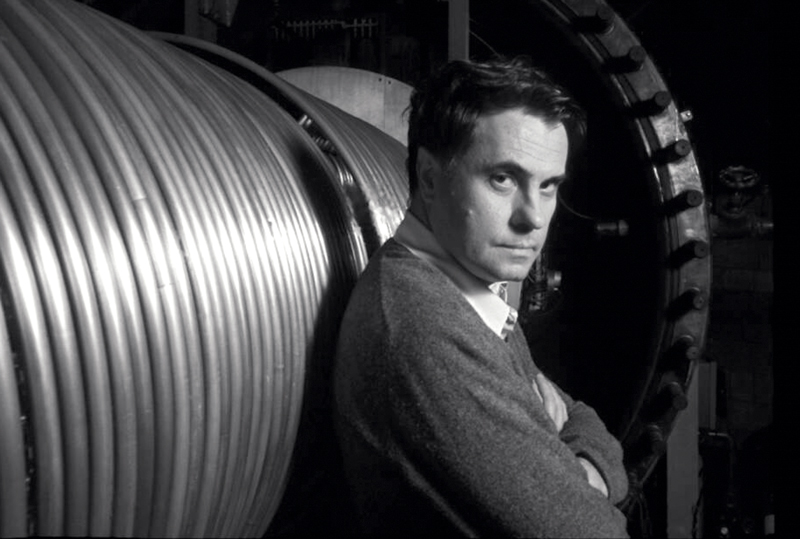
GURGEL, I. and MUNHOZ, M. G. et al. (orgs.). 50 years with the Pelletron particle accelerator: Voices from history. 2022
Oscar Sala, creator of the PelletronGURGEL, I. and MUNHOZ, M. G. et al. (orgs.). 50 years with the Pelletron particle accelerator: Voices from history. 2022The new accelerator promised greater efficiency and lower maintenance costs than its competitors, but it was a new product whose performance had not yet been tested. Sala convinced USP and the federal government to invest in the Pelletron so as not to risk falling behind in the technology race. The Brazilian Development Bank (BNDES) allocated the equivalent of US$18 million in inflation-adjusted funds to purchase the device.
The Pelletron imported into Brazil was the first sold by NEC, which later made some changes in São Paulo, proving to be better than the originals. For the USP team, the pioneering spirit came at a cost. “It was like an apartment bought prior to construction, without carpeting, lighting, or furniture,” compares physicist Ivã Gurgel, coordinator of the IF-USP historical archive and co-organizer of the collection of interviews on the accelerator’s history. The team had to develop an ion source to inject atomic particles into the machine, devices to distribute them to the instruments attached to the other end, and systems to collect, process, and analyze the experiment’s data on computers.
The ion source is on the eighth floor of the building where the accelerator is installed. The ion beam formed by the material introduced into the device is attracted to the accelerator tube inside a tank that occupies three floors. Steel-coated concrete doors were designed to prevent radiation leaks. From there, the accelerated particles are directed by electromagnets and other devices to systems attached to the device’s outlet, in the underground laboratory area.
From an early stage, Sala and his team opted to develop technology at the university itself. The group had a large IBM computer, and the company even offered a newer one with ready-to-use data detection systems, but the offer was declined. “If we had bought a sophisticated, complex unit like that, without any experience, the first time it broke down, we’d be lost,” Sala said in a statement to the Getulio Vargas Foundation’s (FGV) Center for Research and Documentation on Contemporary Brazilian History (CPDOC), in 1977.
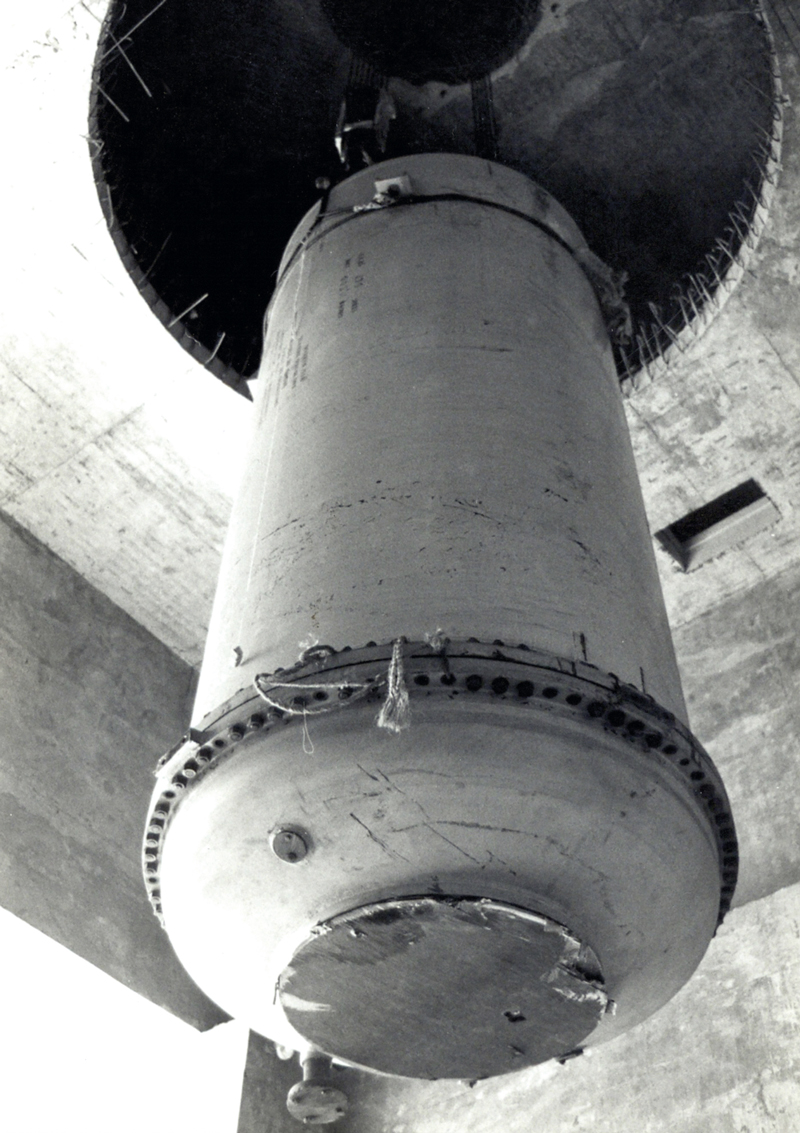
GURGEL, I. and MUNHOZ, M. G. et al. (orgs.). 50 years with the Pelletron particle accelerator: Voices from history. 2022
Installation of the accelerator tank in the early 1970sGURGEL, I. and MUNHOZ, M. G. et al. (orgs.). 50 years with the Pelletron particle accelerator: Voices from history. 2022As economist Tharsila Reis de Medeiros notes in her dissertation, defended at the University of Campinas’s Institute of Geosciences (IGE-UNICAMP) in 2012, the decision to develop local systems yielded good results for a while but was ultimately called into question with the emergence of microcomputers and other advances that left Brazil trailing in the IT field.
Several of the Pelletron’s devices have been updated in recent years, but the lack of continuous cashflow to maintain and modernize the equipment has resulted in delayed renovations and has forced scientists to devote much of their time to resolving technical issues. “Here, everyone has to roll up their sleeves and fight for the data,” says physicist Valdir Scarduelli, recently hired as a professor at the Institute and deputy director of the laboratory. “Our training is more thorough as a result.”
Nine professors and 15 technicians are involved in the Pelletron’s operations today. In 2015, the laboratory began investing in developing a digital control system for the optical instruments used to direct the particle beam within the accelerator. The goal is to allow adjustments to be made remotely in the machine’s control room, without someone having to go up and down the building’s stairs. The team’s technician has been gradually working on this and it should take a few years to complete.
It is a different reality than that of the scientists working with powerful accelerators built abroad in recent years, such as the Large Hadron Collider (LHC), operated by the European Organization for Nuclear Research (CERN), at the border between France and Switzerland. “There, I don’t even get close to the accelerator, and I can concentrate on analyzing the data,” says Munhoz, who is working on an international project with the LHC. In operation since 2008, the device is the world’s largest particle accelerator, capable of reaching up to 7 trillion volts of energy.
“Wealthy countries decommissioned most accelerators the size of the Pelletron because they had the funds to build much larger facilities and do other types of research. But they have not all been decommissioned and several similar accelerators still contribute to research, for example, to study nuclear reactions in stars or to verify small deviations from the predictions made according to the Standard Model of Particle Physics [a theory to describe the behavior of particles and their interactions since the beginning of time],” says Hungarian-Brazilian physicist Alinka Lépine-Szily, a professor at USP who was in charge of the Pelletron from 2007 to 2011. “Brazil can’t afford a much larger laboratory, but we can still do a lot with this equipment.”
In the early 1980s, when the Pelletron had one decade under its belt, Sala realized the need to go one step further to keep the laboratory competitive. He proposed forging an agreement with the Argonne National Laboratory in the United States, which had developed another type of device to study atomic nuclei, using radio frequencies to accelerate particles. It could be connected to the Pelletron’s output to amplify the effects of the energy generated by the device.
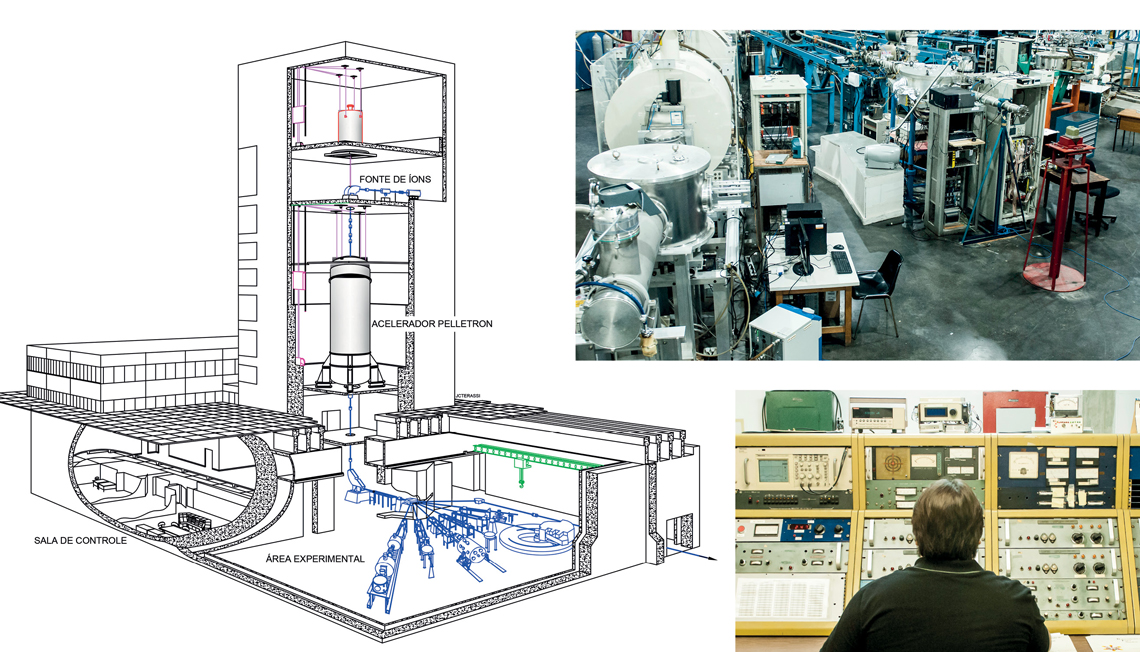
Photos: Léo Ramos Chaves / Pesquisa Fapesp | Illustration João Carlos Terassi / IF-USP
Diagram of the Open Nuclear Physics LaboratoryPhotos: Léo Ramos Chaves / Pesquisa Fapesp | Illustration João Carlos Terassi / IF-USPThe institute created the Linear Accelerator Laboratory (LINAC) in the same building as the Pelletron and bought some of the necessary equipment, but the equipment designed at Argonne has not yet been assembled. Sala suffered a stroke and was unable to continue running the business. Scarduelli estimates that upon project completion, the energy generated by the Pelletron would double, but they are lacking funds, technicians, and professors who can be exclusively devoted to it.
Participation by USP physicists in developing the chips for the satellite program may have paved the way for a solution. In the CITAR project, completed this year, the Pelletron was used to test the components created for other laboratories and indicate necessary adjustments. The machine, however, does not cover all tests required to certify the devices according to international standards. In theory, this problem could be solved by completing the Linear Accelerator Laboratory, which would allow the Pelletron to offer certification services to circuit manufacturers.
Funding for this development could come from launching a new phase of CITAR, currently being discussed by the federal government with the National Institute for Space Research (INPE) and other institutions participating in the program. In May of this year, at the end of an event celebrating the Pelletron’s 50th anniversary, the then director of IF-USP’s LAFN, Rubens Lichtenthäler Filho, mentioned this possibility when asked about the future. “The last thing we can do is give up,” he said. “In this case, I think there actually is a light at the end of the tunnel.”
Republish